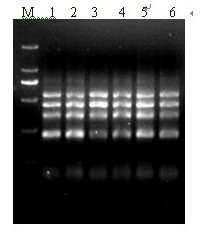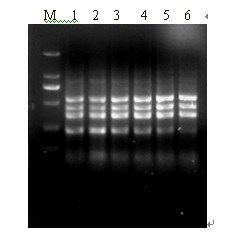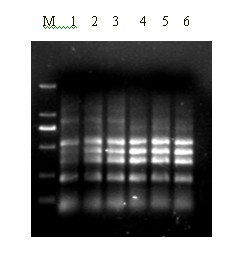Multiple RT-PCR (reverse transcription-polymerase chain reaction) detection method for SPVD (sweet potato virus disease)
A technology of RT-PCR and detection method, which is applied in the field of bioengineering to achieve the effect of strengthening early warning and control
- Summary
- Abstract
- Description
- Claims
- Application Information
AI Technical Summary
Problems solved by technology
Method used
Image
Examples
Embodiment 1
[0048] Embodiment 1: the multiplex RT-PCR detection method of sweet potato virus disease SPVD
[0049] (1) Materials and methods
[0050]1. Design and synthesis of primers:
[0051] According to the genome sequences of SPCSV and SPFMV viruses, the following primers were designed, and the primers were synthesized by TaKaRa Company. The primer sequences are shown in Table 1 below.
[0052]
[0053] Note: where Y=C / T, D=G / A / T, R=A / G, M=A / C.
[0054] 2. Virus material
[0055] Sweet potato stems with typical SPVD symptoms were collected in Guangdong, Sichuan, Jiangsu and other places and planted in insect-proof greenhouses. Serological methods and single PCR methods were used to detect SPCSV and SPFMV to determine the SPVD virus, and confirmed by nucleotide sequencing. For the strain type of SPFMV, several strains of SPVD susceptible sweet potato plants were finally selected for future use.
[0056] 3. Enzyme and reagent (box)
[0057] UNIQ-10 column total RNA extraction ...
PUM
 Login to View More
Login to View More Abstract
Description
Claims
Application Information
 Login to View More
Login to View More - R&D
- Intellectual Property
- Life Sciences
- Materials
- Tech Scout
- Unparalleled Data Quality
- Higher Quality Content
- 60% Fewer Hallucinations
Browse by: Latest US Patents, China's latest patents, Technical Efficacy Thesaurus, Application Domain, Technology Topic, Popular Technical Reports.
© 2025 PatSnap. All rights reserved.Legal|Privacy policy|Modern Slavery Act Transparency Statement|Sitemap|About US| Contact US: help@patsnap.com



